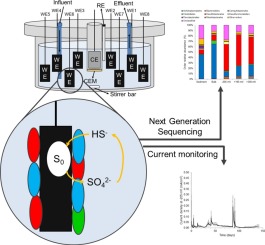Journal of Hazardous Materials ( IF 13.6 ) Pub Date : 2018-08-16 , DOI: 10.1016/j.jhazmat.2018.08.016 Matteo Daghio , Eleni Vaiopoulou , Federico Aulenta , Angela Sherry , Ian Head , Andrea Franzetti , Korneel Rabaey

|
Sulfate reducing microorganisms are typically involved in hydrocarbon biodegradation in the sea sediment, with their metabolism resulting in the by-production of toxic sulfide. In this context, it is of utmost importance identifying the optimal value for anodic potential which ensures efficient toxic sulfide removal. Along this line, in this study the (bio)electrochemical removal of sulfide was tested at anodic potentials of −205 mV, +195 mV and +300 mV vs Ag/AgCl), also in the presence of a pure culture of the sulfur-oxidizing bacterium Desulfobulbus propionicus. Current production, sulfide concentration and sulfate concentration were monitored over time. At the end of the experiment sulfur deposition on the electrodes and the microbial communities were characterized by SEM-EDS and by next generation sequencing of the 16S rRNA gene respectively. Results confirmed that current production is linked to sulfide removal and D. propionicus promoted back oxidation of deposited sulfur to sulfate. The highest electron recovery was observed at +195 mV vs Ag/AgCl, and the lowest sulfur deposition was obtained at −205 mV vs Ag/AgCl anode polarization.
中文翻译:

阳极电位选择,以去除受污染的海洋沉积物中的硫化物
还原硫酸盐的微生物通常参与海底沉积物的烃类生物降解,其代谢会导致有毒硫化物的副产物。在这方面,至关重要的是确定阳极电位的最佳值,以确保有效地去除有毒的硫化物。沿着这条线,在这项研究中,在相对于Ag / AgCl的阳极电势为-205 mV,+ 195 mV和+300 mV的阳极电势下测试了硫化物的(生物)电化学去除),同时也存在纯硫磺培养物。氧化细菌丙酸脱硫球菌。随时间监测当前产量,硫化物浓度和硫酸盐浓度。在实验结束时,分别通过SEM-EDS和16S rRNA基因的下一代测序来表征硫在电极和微生物群落上的沉积。结果证实,目前的生产与硫化物的去除有关,丙酸杜氏菌促进了沉积的硫反氧化为硫酸盐。相对于Ag / AgCl,在+195 mV处观察到最高的电子回收率,而相对于Ag / AgCl的阳极极化,在-205 mV处获得的硫沉积最低。



























 京公网安备 11010802027423号
京公网安备 11010802027423号